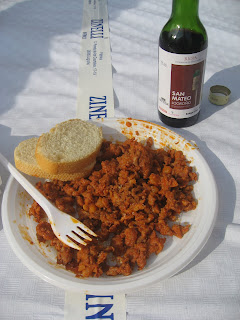
We are back in Logrono this school year. The patron saint of the city is Saint Matthew, or San Mateo. The fiesta of San Mateo goes on for a whole week, in which students don't have class and there are a few days off of work for everyone else. It's true; we the youth have no idea how good we have it.
The picture above is a fountain turned red for the fiestas. The water runs red with the blood of the Logroneses from years ago, who worked hard to create the vineyards and wineries that today we all enjoy so much.

Yes, the wine is good. We went to some tastings and bought some local specialties and reasonable prices. This dish is called 'picadillo', which is basically like spiced pork. It's delicious, and they provided us with a mini wine bottle commemorating the festival and containing a young wine from one of the oldest and most prestigious wineries.

Here's me with another pincho (little Spanish snack/bar food!). I gotta be honest, I don't remember what it is. I should've written it down I guess.
Street performers. They crowd to the fiestas, or anywhere where there are a lot of people. This guy was dressed up as a toy soldier from Toy Story.

There was a wine taster in one of the squares near our apartment. Pay five Euros and you get to wear a glass around your neck while they fill it for you and send you off to bump into other people, who also have wine glasses hanging from their necks.

Here's a view from one of our balconies. We have several in our main living room, and more windows in the bedrooms, kitchen, and bathroom. It's a fairly big place: three bed, one full bath, small kitchen, storage closet, living room with dining table, couch, coffee table, TV, a couple cabinets, some shelves, etc.
Anyways, our situation is on standby. Two of the bedrooms are stilled filled with junk from the previous occupant. He's coming to get it all soon, and then our landlady is going to furnish them. She'll put another bed and dresser in one of the bedrooms and a desk and book shelf in the other. As for now, my dresser is the cabinet in the living room, and my hamper is on top of dude's junk in the other bedroom.

This is a busy street during the fiestas. There are more people in Logrono during the 'sanmateos' than any other time of the year. It's a mess if you wanna go to your favorite places, and many locals--after experiencing the fiesta many times before, no doubt--take the opportunity to go on vacation.

Abby and I lived on this street last year. There are a lot of bars and clubs, and they were all open and all hours of ridiculousness during the fiesta. Par-Tay!

The bullfight ring in Logrono, complete with ultra modern retractable roof! How traditional is this anyway? So there were actually bullfights: those with the bull death and the gorging of matadors and the like; and we didn't go. Instead we went to something called 'vaquillas', which are like bullfights without swords. Entertainers basically just go out with a bull (smaller than the big ones they 'fight' and with taped up horns) and they run around with it, put rings on its horns as it tries to kill them, and by some act of fearlessness some of them actually leap over the large charging animals. Good stuff.
Some of the ceremonies during the fiestas include wine stomping! It's the beginning of harvest time in La Rioja (during autumn), and the stomping creates the season's first (symbolic) mosto! Mosto is grape juice; it's the liquid that comes from the grapes, and when it's fermented you get wine. Increible!
There were also concerts everynight in some of the bigger plazas in the city, and there was also a fireworks contest with different countries and Spanish cities competing. I don't know who won. Several of them were very good.
Well, more coming later, amigos. Hasta luego!
 Here's one of the principal entrances into the old part of the city.
Here's one of the principal entrances into the old part of the city. Once again we can see the image of Santiago (St. James the Apostle) guarding another entrance to the city.
Once again we can see the image of Santiago (St. James the Apostle) guarding another entrance to the city. The city has grown considerably outside the wall, and only the oldest part of town lies inside.
The city has grown considerably outside the wall, and only the oldest part of town lies inside. Lugo's cathedral forms a part of the city's fortress as well, as was quite common in many ancient Roman cities.
Lugo's cathedral forms a part of the city's fortress as well, as was quite common in many ancient Roman cities.
 The tapas were very very good in Lugo. Once again, tapas are Spanish bar food that people generally get free with the purchase of a drink. The tradition is to go from bar to bar trying different things. I have hear an olive anchovie combination. Galicia is famous for its seafood and fish (being so close to the sea/ocean and all).
The tapas were very very good in Lugo. Once again, tapas are Spanish bar food that people generally get free with the purchase of a drink. The tradition is to go from bar to bar trying different things. I have hear an olive anchovie combination. Galicia is famous for its seafood and fish (being so close to the sea/ocean and all). Oysters filled with veggies... mmm.
Oysters filled with veggies... mmm.


































